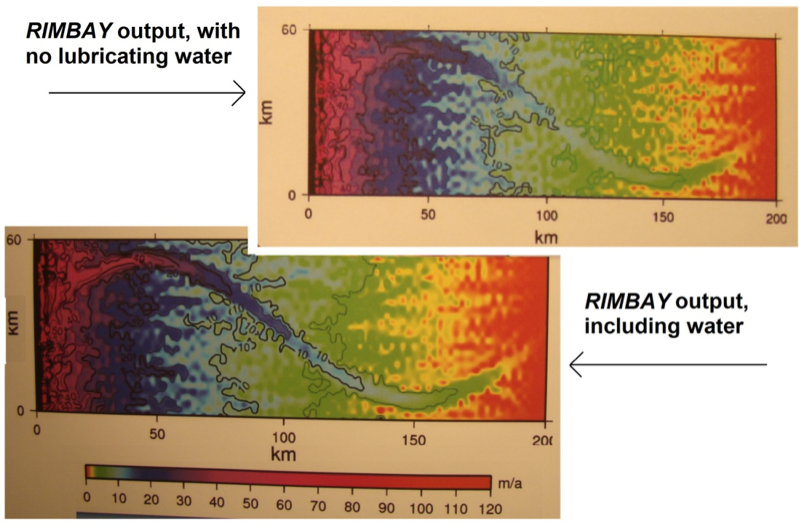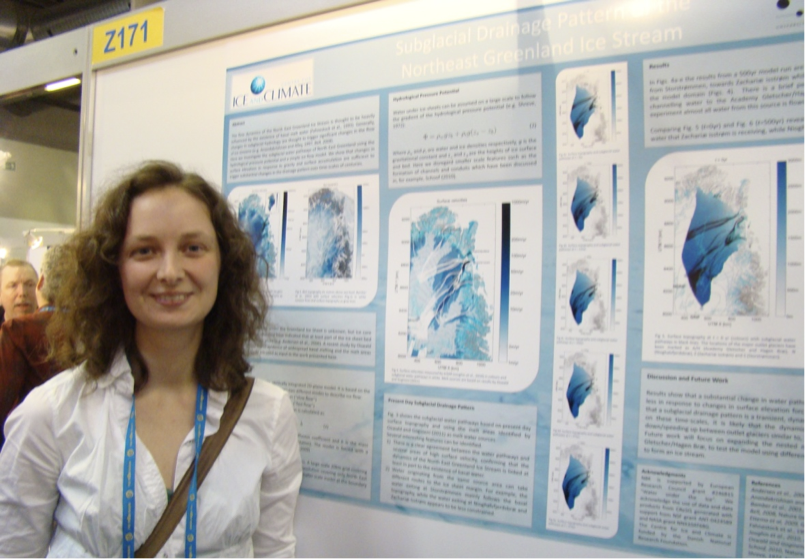Fresh from leading a team of UK geophysicists on a two-week campaign of seismic investigations in northern Sweden, Dr Adam Booth of Swansea University reports to us from the halls of the 2012 General Assembly in Vienna.
Hi, from a very sunny Vienna! It’s my first day at the EGU General Assembly, and the whole city is under bright sunshine and blue skies. Over the next few days, I’ll be blogging about presentations from within the Assembly’s Cryosphere division… Snow, ice, glaciers – the parts of the world that are typically much colder than the Austrian capital today!
My own role in cryospheric science is as a field geophysicist: I use various geophysical systems on the surface of glaciers and ice sheets to interpret the processes that are acting deeper down. Some of the most fundamental influences on glacier flow act directly at the glacier bed, and much of my research effort is directed towards understanding the interaction between ice and its subglacial system. What better way to kick off my conference, then, with sessions dedicated to ‘Subglacial Environments of Ice Sheets and Glaciers’?!
Attending this session leaves a field geophysicist somewhat staggered by the complexity of the problem! Convened by Dr Bryn Hubbard (Aberystwyth University, UK), the session’s presenters consider the diverse and multi-scale interactions between a glacier and the material it sits on. I therefore perused Monday’s presentations and poster programme with great interest, later catching up with some of the authors to get deeper into how we characterise the hidden subglacial world. In places, it seems, that hidden world is a very wet one, and the influence of subglacial water is high on the agenda. From its detection through to modelling its influence, and predicting how networks of water channels will evolve, there is water, water everywhere.
The influence of subglacial water on ice dynamics is a current hot-topic in glaciology. Sebastian Goeller, together with colleagues at the Alfred Wegener Institute (AWI; Bremerhaven, Germany), has a truly multi-disciplinary take on understanding its relation to the Antarctic ice sheet. Beneath Antarctica lie more than 300 subglacial lakes – vast reservoirs of water that are plumbed into a subglacial river network and. The influence of these reservoirs is particularly strong where they are located close to the onset of ‘ice streams’, the fast-flowing conveyor belts that drain most of the ice that is lost from the continent. Sebastian tells me how the AWI are developing a new computational model (called RIMBAY) that improves the representation of ice streams by including complex subglacial topography. As a geophysicist, I’m used to seeing how dramatic that topography can be (for those who’ve seen Lord of the Rings, imagine a postcard from Mordor) – but current models typically consider a greatly-smoothed ice bed. “It’s an enhanced modelling approach,” says Sebastian, “that gives better representation of the subglacial tributary system.”
It certainly makes sense –by having RIMBAY route water through a more realistic network of channels, it more quickly pools beneath ice streams and enhances their flow velocity (see below). RIMBAY is a complex beast, that takes quite a lot of computational power: Sebastian would like to see it applied to the whole Antarctic, but – for now – a small subsection close to the Recovery subglacial lakes will suffice!
Outputs from AWI’s RIMBAY subglacial water model, from Sebastian Goeller’s poster, showing the representation of a sinuous, fast-flowing, ice stream. Upper: an ice stream defined with a ‘conventional’ set of model parameters. The ice stream is visible, but is not well-defined. Lower: RIMBAY unleashed! Subglacial topography is honoured, and water flow is focused more effectively beneath the ice stream; it’s fast-flow characteristics become very well defined.
To make matters worse, a further complication in an already complex problem is that a subglacial water system can also evolve over relatively short time frames. PhD student Tom Cowton (University of Edinburgh, UK) and Dr Paul Smeets (Utrecht University, Netherlands) interpreted changes in the subglacial drainage network beneath the West Greenland Ice Sheet, through respective dye tracing and glacier drilling programmes. Their independent research points to the same conclusion: subglacial flow at the start of summer is sluggish – but with the erosive power of an increasing amount of meltwater, subglacial sediment is flushed out and an efficient drainage network develops. Under such a regime, it is difficult to increase subglacial water pressure, and water then offers no influence on rapid ice sheet flow.
But a single summer is nothing to post-doc Nanna Karlsson (University of Copenhagen, Denmark), who takes the time-scale one step further. Over the course of a few hundred years, Nanna’s work suggests that there can be major shifts in subglacial water flow that can cause entire regions of the ice sheet to stop moving altogether. I’m surprised to learn how sensitive this relationship is: having identified subglacial flow pathways, Nanna observes that “just a few metres of surface elevation change can change subglacial flow quite dramatically” – which, to me, seems quite plausible under a warming climate scenario.
Nanna Karlsson presents “Subglacial drainage pattern of the northeast Greenland ice stream” (CR5.40, EGU2012-882).
Glaciers come in all shapes and sizes, but it seems that the underside of our ice masses might be just as variable as their surface. Furthermore, the subglacial environment is clearly a complex place, and one that seems increasingly fundamental to understanding glacier dynamics. I’ll be sure to keep a look out for evidence of these effects in my own geophysical data.
By Adam Booth, post-doc at Swansea University


